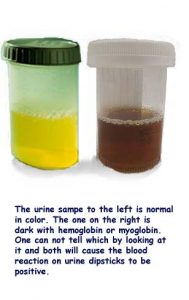
Why Is My Dog Or My Cat’s Blood Or Urine Myoglobin Level High?
Ron Hines DVM PhD
 See What Normal Blood & Urine Values Are
See What Normal Blood & Urine Values Are
 Causes Of Most Abnormal Blood & Urine Tests
Causes Of Most Abnormal Blood & Urine Tests
Myoglobin In Your Dog or Cat’s Blood (=myoglobinemia) Or Myoglobin In Its Urine (=myoglobinuria)
Myoglobin belongs in your pet’s muscle cells – not free in its blood stream or urine.
Your dog and cat stores oxygen in two slightly different carrier molecules. One is the hemoglobin that makes up ~94% of the dry weight of your pet’s red blood cells. Hemoglobin’s job is to transport oxygen throughout the body.
The other oxygen transport molecule is myoglobin, Myoglobin is a smaller but similar compound that stores oxygen within muscle and heart cells for times when more oxygen is needed. Both contain heme, an iron-containing compound. It is the heme enzymes (heme-dependent peroxidases, = “peroxidase-like” activity) that give a positive reaction on the blood detection portion of standard urine test dipsticks that your veterinarian uses to detect blood in your pet’s urine. In those simple tests, the reaction of one is the same as the reaction of the other. Most often, it is the hemoglobin from blood leaking into your dog or cat’s urine from some point in its urinary tract that is the source of a blood-positive result. But on rare occasions, a “blood-positive” urine sample is actually a myoglobin positive urine sample.
As I mentioned, when hemoglobin is detected in your pet’s urine (hematuria), it is usually due to red blood cells leaking into the urine through some lesion or tear. That could be due to an infection. It could be due to a urinary tract stone. It could be due to a traumatic accident. It could also be due to spill-over of free hemoglobin liberated into your pet’s blood stream after some event that destroyed red blood cells while they were still in circulation (a hemolytic anemia) or some toxic event or compound that caused the pet’s red blood cells to rupture (lyse).
But when the positive reaction is actually detecting myoglobin (myoglobinuria), it is because muscle cells were injured somewhere in your dog or cat’s body. That is generally due to some traumatic event involving the pet’s muscles or a recent period of over-exertion. Even the seizures that sometimes accompany heat stroke can be the underlying cause.
Urine that contains myoglobin is often visibly dark or brownish. On microscopic examination, there will be no red blood cell remains present (other than in the very unlikely situation of having the two health issues occurring simultaneously).
Your veterinarian is unlikely to attempt any tests that distinguish between myoglobin and hemoglobin (immunoassays exist, but they are rarely used). But the pet’s recent history that you furnish might cause your veterinarian to suspect one over the other. Was the animal hit by a car? Did it experience other trauma? Was it undergoing extreme exertion? Perhaps a heatstroke? Are muscles areas painful, stiff swollen or bruised? Are claws or teeth broken? If so, your vet will probably look at your dog or cat’s CK (and most likely AST) levels as well. If both of them are elevated, muscle injury and myoglobin might account for your pet’s positive urine results.
Muscle damage and free myoglobin in the blood or urine is a rare event. (myoglobinemia/myoglobinuria). It is seen most frequently in working greyhounds and other sight hounds – because of their strenuous lifestyle, muscle conformation and unique metabolism. When it occurs, the condition is called rhabdomyolysis. Theoretically, any severe muscle trauma, crushing, struggling, exertion or prolonged restraint of any pet could cause rhabdomyolysis. I have not run into this problem in dogs or cats. I do see it frequently in wildlife (another interest of mine) where it is called “capture myopathy”. In those animals, it often results in kidney failure and death as the breakdown products of muscles damaged during struggling clog and disable the animal’s kidney sieve-like nephrons.
Complementary tests:
CBC/ WBC and blood chemistry panel, with particular attention to CK and ALT levels, muscle biopsy
DxMe


